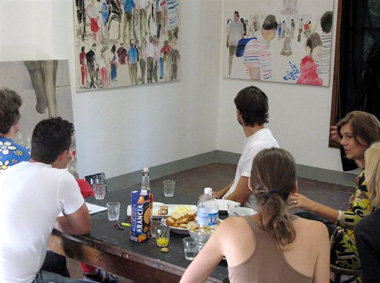Freisteller
dal 25/4/2008 al 21/6/2008
Segnalato da
25/4/2008
Freisteller
Deutsche Guggenheim, Berlin
Villa Romana Fellows 2008. In the exhibition are displayed new paintings, installations and videos by Dani Gal, Julia Schmidt, Asli Sungu and Clemens von Wedemeyer. The Villa Romana Fellowship, awarded to exceptional young talents since 1905, includes a stipend and a residency program, allowing fellows to live and work for ten months in the artists' house in Florence.

curated by Angelika Stepken
Dani Gal, Julia Schmidt, Aslı Sungu, Clemens von Wedemeyer
For the first time, the Deutsche Guggenheim in Berlin will introduce the recipients of the Villa Romana Fellowship: from April 26 through June 22, 2008, new paintings, installations and videos by Dani Gal, Julia Schmidt, Aslı Sungu and Clemens von Wedemeyer will be displayed at the exhibition hall on Unter den Linden.
The Villa Romana Fellowship, awarded to exceptional young talents since 1905, includes a stipend and a residency program, allowing fellows to live and work for ten months in the artists’ house in Florence. This art prize is not just the oldest in Germany, but it also represents Deutsche Bank's longest cultural commitment. The presentation at the Deutsche Guggenheim marks a new milestone in the institution’s partnership with the arts, while also continuing the series of exhibitions conceived by Deutsche Bank within its joint venture with the Solomon R. Guggenheim Foundation.
Freisteller was curated by Angelika Stepken, Director of the Villa Romana. The fellows were selected by the Berlin artist Ayse Erkmen and the art historian Beatrice von Bismarck from Leipzig.
The German term “Freisteller,” used in photography, printing and computer graphics, describes an image that is cut out from its background and context in order to insert it into a new composition. “Freisteller” is also the title of the current exhibition at the Deutsche Guggenheim, introducing the Villa Romana Fellows—four young artists with diverse biographies and nationalities working in various media. At first glance, Dani Gal, Julia Schmidt, Aslı Sungu and Clemens von Wedemeyer seem to have only two things in common: they live and work in Germany, and they will now spend time together in a new cultural and geographical environment—as residents of the renowned artists’ house in the hills of Florence.
Yet, as the exhibition title suggests, the selected artists share a number of common interests and strategies, specifically in the field of photography.
They disconnect motifs and themes from their original context and, through this process of “cutting out,” open onto new discursive relations. Dani Gal combines influences from popular culture with historical research; Julia Schmidt works with found images from magazines and the internet, which she isolates and fragmentizes in her paintings; Aslı Sungu’s videos explore everyday activities to show how our conception of identity, of “right” or “wrong” are socially determined; and Clemens von Wedemeyer’s films fuse elements of political documentation with fiction to expose the interplay between concrete social situations and media representation.
The organization of the exhibition space as well departs from the hermetic, protective structure of the “white cube.” The window front of the Deutsche Guggenheim is opened up, while partition walls and platforms serve as display units for the artwork. Encountered within this temporary exhibition architecture, the presented positions achieve a dual purpose: they offer insights into the creative practice of each of the recipients, and they address a broad spectrum of questions raised by contemporary art—media and institutional critique, migration, and the ability to articulate critical and political viewpoints.
The exhibition Freisteller documents how an institution like the Villa Romana, rich in tradition and far from the great metropolitan centers, can succeed in becoming a creative think tank of contemporary art and a place for intercultural exchange. Equally notable is the fact that the Villa Romana Fellows are now for the first time presented at the Deutsche Guggenheim. The affiliation between both institutions establishes a public forum that is capable of reflecting authentically the vital, internationally oriented art scene in Germany.
On the occasion of the current exhibition, a catalogue will be published in German/English and German/Italian with texts and artist interviews by Clemens Krümmel, Bert Rebhandl, Angelika Stepken and René Zechlin; book design by atelier september, Karlsruhe; 29 Euro.
Edition No. 43/1–4, issued in conjunction with Freisteller, consists of: No. 43/1 Dani Gal: i.e., 2008; No. 43/2 Julia Schmidt: Untitled (stripper), 2008; No. 43/3 Aslı Sungu: Almost, 2008; and Clemens von Wedemeyer: Der überflüssigen Bevölkerung, 2008. All editions can be purchased exclusively at the Deutsche Guggenheim’s MuseumsShop; prices on request, (030) 20 20 93-15 /-16.
A variety of special events are scheduled during the exhibition, including artist’s talks, lectures and a children’s program. Free guided tours daily at 6 p.m. The popular lunch lectures on Wednesday, 1 p.m., and tours focusing on specific topics on Sunday, 11:30 a.m., complete the program.
To celebrate the selection of the Villa Romana as a “Landmark in the Land of Ideas,” Angelika Stepken, director of the artists’ house and curator of the exhibition, will conduct a guided tour on May 30.
Press contact: Dr. Bettina Mette
Phone: +49-30-202093-14
Fax: +49-30-202093-20
email: bettina.mette@db.com
Deutsche Guggenheim
Unter den Linden 13/15 - Berlin



